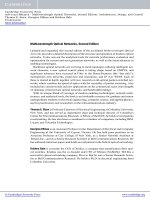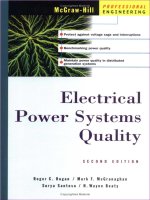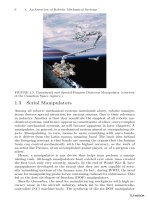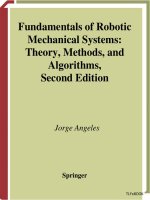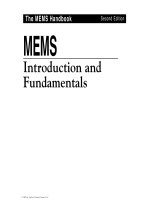- Trang chủ >>
- Khoa Học Tự Nhiên >>
- Vật lý
Understanding smart sensors second editi
Bạn đang xem bản rút gọn của tài liệu. Xem và tải ngay bản đầy đủ của tài liệu tại đây (3.04 MB, 411 trang )
Understanding Smart Sensors
Second Edition
For a listing of recent titles in the Artech House Sensors Library,
turn to the back of this book.
Understanding Smart Sensors
Second Edition
Randy Frank
Artech House
Boston London
Library of Congress Cataloging-in-Publication Data
Frank, Randy.
Understanding smart sensors / Randy Frank.2nd ed.
p.
cm.(Artech House sensors library)
Includes bibliographical references and index.
ISBN 0-89006-311-7 (alk. paper)
1. DetectorsDesign and construction.
2. Programmable controllers.
3. Signal processingDigital techniques.
4. Semiconductors.
5. Application specific integrated circuits.
I. Title.
TA165.F724 2000
681.2dc21
00-021296
CIP
British Library Cataloguing in Publication Data
Frank, Randy
Understanding smart sensors.2nd ed.(Artech House sensors library)
1. DetectorsDesign and construction
2. Programmable controllers
3. Signal processingDigital techniques
4. Application specific integrated circuits
I. Title
681.2
ISBN 1-58053-398-1
Cover and text design by Darrell Judd
Cover image courtesy of Sandia National Laboratories
© 2000 ARTECH HOUSE, INC.
685 Canton Street
Norwood, MA 02062
All rights reserved. Printed and bound in the United States of America. No part of this book
may be reproduced or utilized in any form or by any means, electronic or mechanical, including
photocopying, recording, or by any information storage and retrieval system, without permission in writing from the publisher.
All terms mentioned in this book that are known to be trademarks or service marks have
been appropriately capitalized. Artech House cannot attest to the accuracy of this information.
Use of a term in this book should not be regarded as affecting the validity of any trademark or
service mark.
International Standard Book Number: 0-89006-311-7
Library of Congress Catalog Card Number: 00-021296
10 9 8 7 6 5 4 3 2 1
This Page Intentionally Left Blank
Dedicated to the memory of the one person who would have loved to see this book
but did notmy father, Carl Robert Frank.
Contents
Preface
1
xix
Smart Sensor Basics
1
1.1
1.2
1.3
1.4
Introduction
1
Mechanical-Electronic Transitions in Sensing
4
Nature of Sensors
5
Integration of Micromachining and
Microelectronics
11
1.5
Summary
15
References
16
Select Bibliography
16
Micromachining
17
Introduction
17
Bulk Micromachining
19
Wafer Bonding
21
Silicon-on-Silicon Bonding
22
Silicon-on-Glass (Anodic) Bonding
23
Silicon Fusion Bonding
24
2
2.1
2.2
2.3
2.3.1
2.3.2
2.3.3
vii
viii
Understanding Smart Sensors
2.3.4
Wafer Bonding for More Complex Structures and
Adding ICs
25
2.4
2.4.1
2.4.2
2.4.3
2.4.4
Surface Micromachining
25
Squeeze-Film Damping
29
Stiction
29
Particulate Control
30
Combinations of Surface and
Bulk Micromachining
30
2.5
2.5.1
2.5.2
2.5.3
2.5.4
2.5.5
2.6
2.6.1
2.6.2
2.6.3
2.6.4
2.7
Other Micromachining Techniques
31
LIGA Process
32
Dry-Etching Processes
32
Micromilling
36
Lasers in Micromachining
36
Chemical Etching and IC Technology
37
Other Micromachined Materials
40
Diamond as an Alternative Sensor Material
41
Metal Oxides and Piezoelectric Sensing
41
Films on Microstructures
42
Micromachining Metal Structures
43
Summary
44
References
44
The Nature of Semiconductor Sensor Output
49
Introduction
49
Sensor Output Characteristics
49
Wheatstone Bridge
50
Piezoresistivity in Silicon
52
Semiconductor Sensor Definitions
54
Static Versus Dynamic Operation
57
Other Sensing Technologies
57
Capacitive Sensing
58
Piezoelectric Sensing
59
3
3.1
3.2
3.2.1
3.2.2
3.2.3
3.2.4
3.3
3.3.1
3.3.2
Contents
3.3.3
3.3.4
3.3.5
3.4
3.4.1
3.4.2
3.5
3.6
3.6.1
3.7
3.7.1
3.7.2
3.7.3
3.8
4
4.1
4.2
4.2.1
4.2.2
4.2.3
4.2.4
4.2.5
4.2.6
4.2.7
4.2.8
4.3
4.3.1
4.3.2
4.4
ix
Hall Effect
60
Chemical Sensors
60
Improving Sensor Characteristics
61
Digital Output Sensors
62
Incremental Optical Encoders
63
Digital Techniques
64
Noise/Interference Aspects
65
Low-Power, Low-Voltage Sensors
66
Impedance
67
Analysis of Sensitivity Improvement
67
Thin Diaphragm
67
Increased Diaphragm Area
67
Combined Solution: Micromachining and
Microelectronics
68
Summary
68
References
69
Getting Sensor Information Into the MCU
71
Introduction
71
Amplification and Signal Conditioning
72
Instrumentation Amplifiers
73
SLEEPMODE Operational Amplifier
75
Rail-to-Rail Operational Simplifiers
76
Switched-Capacitor Amplifier
77
Barometer Application Circuit
79
4- to 20-mA Signal Transmitter
79
Schmitt Trigger
79
Inherent Power-Supply Rejection
81
Separate Versus Integrated Signal Conditioning
82
Integrated Passive Elements
83
Integrated Active Elements
84
Digital Conversion
86
x
Understanding Smart Sensors
4.4.1
4.4.2
4.4.3
4.5
A/D Converters
87
Performance of A/D Converters
89
Implications of A/D Accuracy and Errors
90
Summary
91
References
91
Using MCUs/DSPs to Increase Sensor IQ
93
5.1
5.1.1
5.1.2
5.2
5.3
5.3.1
5.3.2
5.3.3
5.3.4
5.3.5
5.3.6
5.3.7
5.4
5.4.1
5.5
5.5.1
5.5.2
5.5.3
5.5.4
5.5.5
Introduction
93
Other IC Technologies
93
Logic Requirements
94
MCU Control
95
MCUs for Sensor Interface
96
Peripherals
96
Memory
97
Input/Output
98
Onboard A/D Conversion
99
5.5.6
5
5.6
5.7
Power-Saving Capability
101
Local Voltage or Current Regulation
103
Modular MCU Design
103
DSP Control
104
Algorithms Versus Lookup Tables
106
Techniques and Systems Considerations
107
Linearization
108
PWM Control
108
Autozero and Autorange
109
Diagnostics
111
Reducing Electromagnetic Compatibility and
Radio Frequency Interference
111
Indirect (Computed, Not Sensed) Versus Direct
Sensing
112
Software, Tools, and Support
112
Sensor Integration
113
Contents
5.8
6
6.1
6.2
6.2.1
6.2.2
6.3
6.4
6.4.1
6.4.2
6.4.3
6.5
6.5.1
6.5.2
6.5.3
6.6
6.7
6.7.1
6.7.2
6.8
6.8.1
6.8.2
6.8.3
6.8.4
6.8.5
6.9
6.9.1
6.9.2
6.9.3
xi
Summary
116
References
116
Communications for Smart Sensors
119
Introduction
119
Definitions and Background
119
Definitions
119
Background
120
Sources (Organizations) and Standards
122
Automotive Protocols
123
SAE J1850
125
CAN Protocol
126
Other Automotive Protocols
129
Industrial Networks
130
Industrial Usage of CAN
130
LonTalk Protocol
131
Other Industrial Protocols
132
Office/Building Automation
133
Home Automation
134
CEBus
135
LonTalk
135
Protocols in Silicon
135
MCU With Integrated SAE J1850
135
MCU With Integrated CAN
137
Neuron® Chips and LonTalk Protocol
139
MI-Bus
141
Other MCUs and Protocols
142
Other Aspects of Network Communications
142
MCU Protocols
143
Transition Between Protocols
143
Transition Between Systems
144
xii
Understanding Smart Sensors
6.9.4
6.10
7
7.1
7.1.1
7.1.2
7.1.3
7.2
7.3
7.4
7.5
7.6
7.6.1
7.7
7.7.1
7.7.2
7.8
7.9
8
8.1
8.1.1
8.1.2
8.2
8.2.1
8.2.2
8.2.3
8.2.4
8.3
The Protocol as a Module
145
Summary
146
References
146
Control Techniques
149
Introduction
149
Programmable Logic Controllers
150
Open- Versus Closed-Loop Systems
150
PID Control
150
State Machines
154
Fuzzy Logic
155
Neural Networks
157
Combined Fuzzy Logic and Neural Networks
160
Adaptive Control
161
Observers for Sensing
162
Other Control Areas
164
RISC Versus CISC
165
Combined CISC, RISC, and DSP
167
The Impact of Artificial Intelligence
168
Summary
169
References
170
Transceivers, Transponders, and Telemetry
173
Introduction
173
The RF Spectrum
174
Spread Spectrum
177
Wireless Data and Communications
179
Wireless Local Area Networks
180
FAX/Modems
180
Wireless Zone Sensing
181
Optical Signal Transmission
182
RF Sensing
183
Contents
8.3.1
8.3.2
8.3.3
8.3.4
8.3.5
8.3.6
8.3.7
8.3.8
8.3.9
8.4
8.5
8.6
9
9.1
9.2
9.2.1
9.2.2
9.2.3
9.2.4
9.2.5
9.2.6
9.3
9.3.1
9.3.2
9.3.3
9.3.4
9.3.5
9.3.6
9.3.7
xiii
Surface Acoustical Wave Devices
183
Radar
183
Global Positioning System
185
Remote Emissions Sensing
186
Remote Keyless Entry
187
Intelligent Transportation System
188
RF-ID
191
Other Remote Sensing
192
Measuring RF Signal Strength
192
Telemetry
192
RF MEMS
195
Summary
196
References
197
MEMS Beyond Sensors
201
Introduction
201
Micromachined Actuators
203
Microvalves
203
Micromotors
203
Micropumps
206
Microdynamometers
208
Microsteam Engines
210
Actuators in Other Semiconductor Materials
210
Other Micromachined Structures
211
Cooling Channels
211
Microoptics
213
Microgrippers
214
Microprobes
214
Micromirrors
215
Heating Elements
217
Thermionic Emitters
217
xiv
Understanding Smart Sensors
9.3.8
9.3.9
9.3.10
9.3.11
9.3.12
9.4
10
10.1
10.2
10.2.1
10.3
10.3.1
10.3.2
10.3.3
10.3.4
10.4
10.4.1
10.4.2
10.4.3
10.4.4
10.5
10.5.1
10.5.2
10.6
10.7
11
11.1
Field Emission Displays
219
Unfoldable Microelements
219
Micronozzles
221
Interconnects for Stacked Wafers
222
Nanoguitar
222
Summary
223
References
223
Packaging, Testing, and Reliability
Implications of Smarter Sensors
227
Introduction
227
Semiconductor Packaging Applied to Sensors
228
Increased Pin Count
231
Hybrid Packaging
231
Ceramic Packaging and Ceramic Substrates
232
Multichip Modules
232
Dual-Chip Packaging
233
Ball Grid Array Packaging
234
Packaging for Monolithic Sensors
235
Plastic Packaging
236
Surface-Mount Packaging
236
Flip-Chip
237
Wafer-Level Packaging
238
Reliability Implications
239
The Physics of Failure
242
Wafer-Level Sensor Reliability
243
Testing Smarter Sensors
244
Summary
245
References
246
Mechatronics and Sensing Systems
249
Introduction
249
Contents
11.1.1
11.2
11.3
11.3.1
11.3.2
11.3.3
11.3.4
11.4
11.4.1
11.4.2
11.4.3
11.5
11.5.1
11.5.2
11.5.3
11.6
xv
Integration and Mechatronics
250
Smart-Power ICs
250
Embedded Sensing
252
Temperature Sensing
252
Current Sensing in Power ICs
256
Diagnostics
256
MEMS Relays
261
Sensing Arrays
261
Multiple Sensing Devices
261
Multiple Types of Sensors
264
An Integrated Sensing System
265
Other System Aspects
265
Batteries
266
Field Emission Displays
266
System Voltage Transients, Electrostatic Discharge,
and Electromagnetic Interference
267
Summary
270
References
270
Standards for Smart Sensing
273
12.1
12.2
Introduction
273
Setting the Standards for Smart Sensors and
Systems
273
12.3
12.3.1
12.3.2
12.3.3
12.4
12.4.1
12.4.2
12.4.3
12.4.4
IEEE 1451.1
276
Network-Capable Application Processor
276
Network Communication Models
278
The IEEE 1451.1 Example
280
IEEE 1451.2
281
STIM
282
Transducer Electronic Data Sheet
284
TII
285
Calibration/Correction Engine
286
12
xvi
Understanding Smart Sensors
12.4.5
12.4.6
12.5
12.6
12.7
12.8
13
13.1
13.2
13.3
13.3.1
13.3.2
13.4
13.4.1
13.4.2
13.5
13.6
13.6.1
13.6.2
13.7
14
14.1
14.2
14.3
14.4
14.4.1
14.4.2
14.4.3
Sourcing Power to STIMs
289
Representing Physical Units in the TEDS
289
IEEE P1451.3
291
IEEE P1451.4
292
Extending the System to the Network
293
Summary
295
References
295
The Implications of Smart Sensor Standards
297
Introduction
297
Sensor Plug-and-Play
297
Communicating Sensor Data Via Existing Wiring 300
Ethernet
300
Sensing by Modem
300
Automated/Remote Sensing and the Web
301
Wireless Protocol
302
Remote Diagnosis
302
Process Control Over the Internet
303
Alternative Standards
305
Airplane Networks
306
Automotive Safety Network
306
Summary
308
References
308
The Next Phase of Sensing Systems
311
Introduction
311
Future Semiconductor Capabilities
313
Future System Requirements
315
Not-So-Futuristic Systems
317
Fabry-Perot Interferometer
317
HVAC Sensor Chip
318
Speech Recognition and Micromicrophones
319
Contents
14.4.4
14.4.5
14.4.6
14.4.7
14.4.8
14.5
14.5.1
14.6
14.7
14.8
xvii
Electrostatic Mesocooler
320
Microangular Rate Sensors
321
MCU With Integrated Pressure Sensor
321
Wireless Sensing in the Networked Vehicle
323
Personal ID Smart Sensor
324
Software, Sensing, and the System
325
CAD for MEMS
325
Alternative Views of Smart Sensing
326
The Smart Loop
328
Summary
329
References
330
List of Acronyms and Abbreviations
333
Glossary
351
Selected Bibliography
367
Books and Journals
367
Web Sites
368
About the Author
373
Index
375
This Page Intentionally Left Blank
Preface
The number one challenge facing engineers is rapidly changing technology,
according to a 1999 survey [1]. IBM estimates that more data has been generated in the past 30 years than in the previous 5,000 years! There certainly is no
lack of available information on what is happening and the ongoing activities in
the area of sensing, micromachining, and microelectromechanical systems
(MEMS). The difficulty comes in making effective decisions as users of the
technology or establishing a long-range plan of where a company might use
existing and future products to develop end-user products. This book condenses the existing material into a highly readable format and links the variety
of ongoing activities in the smart sensor and MEMS area.
According to Dana Gardner and as noted in the first edition of this book,
By the year 2000, 50% of all engineers will design with sensors, up from 16%
who routinely used them at the beginning of the decade [2]. I do not know if
that prediction came true, but the 1990s certainly should be remembered as the
decade when MEMS technology accelerated from the laboratory into production and the decade that established smart sensors through the IEEE 1451 standard. Micromachining technology will continue to be the primary reason for
sensors achieving cost breakthroughs that allow widespread sensor usage. At the
heart of most smart sensors will be digital integrated circuit technology.
Embedded microcontrollers already play a hidden role in most of the
common activities that occur in our daily lives. Use a cellular phone, receive a
page, watch television, listen to a compact disc, or drive a current model car
and you have the assistance of embedded microcontrollers. For example, there
are a dozen or so microcontrollers in a typical car, over 50 if you drive a wellequipped luxury vehicle. Semiconductor sensors provide many of the inputs to
xix
xx
Understanding Smart Sensors
those devices. The number of sensors and the intelligence level are increasing to
keep up with increasing control complexity.
Semiconductor sensors initially were developed to provide easier-tointerface, lower-cost, and more reliable inputs to electronic control systems.
The microcontrollers at the heart of these systems have increased in complexity
and capability while drastically achieving reduced cost per function. Semiconductor technology has also been applied to the input side for a few sensor
inputs (pressure, temperature, acceleration, optoelectronics, and Hall-effect
devices) but is just starting to broaden in scope (level of integration) and sensed
parameters and to achieve some of the cost-reduction benefits from integration.
The system outputs have done a better job of keeping up with advances
in semiconductor technology. The term smart power refers to semiconductor
power technologies that combine an output power device(s) with control circuitry on the same silicon chip. Both input and output devices are receiving
greater focus, the capability of combining technologies is being extended, and
the need for systems-level communications is finally making smart sensors a
reality.
Wen Ko of Case Western Reserve University established a vision for intelligent sensors [3], but Joe Giachino of Ford Motor Company is frequently
given credit for the term smart sensor, based on his 1986 paper [4]. Several others, including Middelhoek and Brignell, claim part of the credit for pioneering
the concept of smart sensors with capabilities beyond simple signal conditioning. The communication of sensory information is finally requiring consensus
for the true meaning of smart sensor.
The ultimate capabilities of new smart sensors will undoubtedly go far
beyond todays projections. An understanding of what is possible today and
what can be expected in the future is necessary to take the first step toward
smarter sensing systems. This book is intended to provide the reader with
knowledge regarding a broad spectrum of possibilities based on current industry, university, and national laboratories R&D efforts in smart sensors. It discusses many recent developments that will affect sensing technology and future
products.
In this second edition, every chapter has been reviewed, and new, more
current material has been added. The recent balloting and acceptance of IEEE
1451.1 and 1451.2 provided the impetus for updating the first edition.
Chapters 12 and 13 address those important additions to the future of smart
sensing.
I would like to extend my sincere appreciation to Mark Shaw, whose concept of the phases of integration became an underlying theme for this book
and, I believe, the way that smart sensing will evolve. It certainly has held true
Preface
xxi
for well over 6 years. A number of other people played an important role in
making this book a reality:
•
•
•
•
•
Ray Weiss of Computer Design magazine provided methodology guidance and was the prime mover.
Mark Walsh and the team at Artech House were very supportive at
every step in the process.
Lj Ristic, Mark Shaw, Cindy Wood, and Mark Reinhard from
Motorola Semiconductor Products Sector provided chapter reviews.
Carl Helmers and the folks at Sensors magazine and Sensors Expo provided many publishing opportunities that were helpful in documenting several aspects of smart sensors.
Sandia National Laboratories provided material for cover artwork.
Finally, this book would not have been possible without the critical
evaluation, tolerance, and encouragement of my wife, Rose Ann. Any expression of appreciation is small compared to the sacrifices she made.
References
[1]
Design News, Jan. 18, 1999, p. 74.
[2]
Gardner, D. L., Accelerometers for Exotic Designs, Design News, July 17, 1989, p. 55.
[3]
Ko, W. H., and C. D. Fung, VLSI and Intelligent Transducers, Sensors and Actuators, 2
(1982), pp. 239250.
[4]
Giachino, J. M., Smart Sensors, Sensors and Actuators, 10 (1986), pp. 239248.
1
Smart Sensor Basics
A rose by any other name would smell as sweet.
William Shakespeare
A rose with a microcontroller would be a smart rose.
Randy Frank
1.1 Introduction
Just about everything today in the technology area is a candidate for having the
prefix smart added to it. The term smart sensor was coined in the mid-1980s,
and since then several devices have been called smart sensors. The intelligence
required by such devices is available from microcontroller unit (MCU), digital
signal processor (DSP), and application-specific integrated circuit (ASIC) technologies developed by several semiconductor manufacturers. Some of those
same semiconductor manufacturers are actively working on smarter silicon
devices for the input and output sides of the control system as well. The term
microelectromechanical system (MEMS) is used to describe a structure created
with semiconductor manufacturing processes for sensors and actuators. To
understand what is occurring today when advanced microelectronic technology
is applied to sensors, a brief review of the transitions that have occurred is
in order.
Before the availability of microelectronics, the sensors or transducers used
to measure physical quantities, such as temperature, pressure, and flow, usually
were coupled directly to a readout device, typically a meter that was read by an
1
2
Understanding Smart Sensors
observer. The transducer converted the physical quantity being measured to a
displacement. The observer initiated system corrections to change the reading
closer to a desired value. The typical blocks of a measurement system are shown
in Figure 1.1 [1].
Many home thermostats, tire pressure gauges, and factory flow meters
still operate in the same manner. However, the advent of microprocessor technology initiated the requirement for sensors to have an electrical output that
could be more readily interfaced to provide unattended measurement and
control. That also required the analog signal level to be amplified and converted to digital format prior to being supplied to the process controller.
Todays MCUs and analog-to-digital (A/D) converters typically have a 5V
power supply, which has dictated the supply voltage for many amplified
and signal conditioned sensors. However, the reduction in the supply voltage
from 5V to 3.3V and even lower voltages and the presence of more than one
voltage in a system pose challenges not typically associated with even the smartest sensors. Separate integrated circuits (ICs) are available to handle the variety
of voltages and resolve the problem, but they add to system and sensor
complexity.
Commonly used definitions for the terms sensor and transducer must be
the first in the list of many terms that will be defined. A transducer is a device
that converts energy from one domain into another, calibrated to minimize the
errors in the conversion process [2]. A sensor is a device that provides a useful
output to a specified measurand. The sensor is a basic element of a transducer,
but it also may refer to a detection of voltage or current in the electrical regime
that does not require conversion. Throughout this book, the terms are used
synonymously, because energy conversion is part of every device that is discussed. The mechanical measurements that require a transducer to provide an
electrical output are listed in Table 1.1.
Calibration
input
Auxiliary
power (not always
required)
Auxiliary
power (usually
required)
Indicator
Measurand
Sensor/
transducer
Signal
conditioner
Recorder
Processor
Controller
Figure 1.1 General sensing system.
Smart Sensor Basics
3
Table 1.1
Mechanical Measurements
Measurement
Typical/Common Techniques
Displacement/position
Variable reluctance, Hall effect, optoelectronic
Temperature
Thermistor, transistor base-emitter voltage (Vbe)
Pressure
Piezoresistive, capacitive
Velocity (linear/angular)
Variable reluctance, Hall effect, optoelectronic
Acceleration
Piezoresistive, capacitive, piezoelectric
Force
Piezoresistive
Torque
Optoelectronic
Mechanical impedance
Piezoresistive
Strain
Piezoresistive
Flow
∆ pressure, or delta pressure
Humidity
Resistive, capacitive
Proximity
Ultrasonic
Range
Radar
Liquid level
Ultrasonic
Slip
Dual torque
Imminent collision
Radar
The definition of smart sensor (intelligent transducer) has not been as
widely accepted and is subject to misuse. However, an Institute of Electrical
and Electronics Engineers (IEEE) committee has been actively consolidating
terminology that applies to microelectronic sensors. The recently approved
IEEE 1451.2 specification defines a smart sensor as a sensor that provides
functions beyond those necessary for generating a correct representation of a
sensed or controlled quantity. This function typically simplifies the integration
of the transducer into applications in a networked environment [2]. That definition provides a starting point for the minimum content of a smart sensor.
Future smart sensors will be capable of much more, and additional classifications (e.g., smart sensor type 1) may be required to differentiate the products.
Chapter 12 addresses the IEEE-approved smart transducer interface for sensors
and actuators that establishes a standard for transducer-to-microprocessor communication protocols in a transducer electronic data sheet (TEDS) format.
That standard and others will provide further definition and differentiation for


